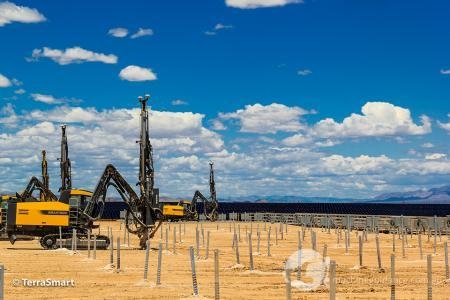Solar Project: Drilling with Machine Guidance
USA contractor TerraSmart combines their innovative solar panel racking foundation techniques with machine guidance drill systems to accurately install 110,000 ground screws, achieving a 50% program acceleration over traditional stakeout methods!
Published: November 2016
Author: Trimble Civil Engineering and Construction Division

Spare

Highlights
Highlights:
- Greater than 50% acceleration in completing each solar panel block, compared to traditional stake and survey methods
- Met hole and ground screw tolerances of +/- 2 centimetres
- Placed approximately 110,000 ground screws with minimal staking
- Saved upwards of $250,000 and significant time in survey costs - eliminated the need for a team of full-time surveyors

Image

1st body copy
TerraSmart leads North America in solar ground mount racking design, engineering, and manufacturing. The company has more than 30 years of experience in structural engineering and steel fabrication. Headquartered in Estero, Florida, TerraSmart delivers the most technologically advanced solar ground mount racking solutions in the industry.
In August of 2015, TerraSmart was hired for the Moapa Solar Energy Center Project in Las Vegas, NV. The Moapa Solar Energy Center Project is a 1,500-acre solar project being constructed on the Moapa River Indian Reservation in Clark County, NV. The massive sustainable energy project is being managed by partnerships with the Bureau of Indian Affairs (BIA) and several other government entities responsible for environmentally-friendly land and business development.
The Moapa solar energy project began in late 2015 and was expected to take 24 months to complete. The project site is divided into nine blocks of solar panels, with each block varying in size from 25 to 75 acres. The plant will utilize photovoltaic (PV) solar technology and, once complete, will generate up to 250 MW of clean energy. Once the solar panel racking system is installed, a single overhead 230 kilovolt (kV) transmission line will connect the solar energy center to the nearby Harry Allen substation.
Solar panels require a strong, durable foundation; contractors have often used piles for solar panel foundations. However, when the soil is extremely rocky, dense and full of caliche, driving piles into the ground becomes a significant challenge.
"We heard from the project owner that other contractors on the Moapa solar site were struggling to drive piles because of the severe, rocky terrain," said, James Meyer, Survey Lead for TerraSmart. "The pile driver used is basically a giant hammer that drives a big beam into the ground and provides a strong, sturdy foundation. However, when rocky ground conditions are present, it is difficult to maintain a level pile while being driven into the ground with the caliche knocking it out of alignment. The previous contractors on this site were having extreme difficulty maintaining the necessary tolerances using the driven pile method."
For blocks one through four on the Moapa solar build, previous contractors had used the driven pile method, which took a year and half to complete - roughly twice as long as expected. Looking for improvements, the general contractor hired TerraSmart to complete blocks five and six.
Instead of driving piles to build the solar panel racking foundation, Meyer explains that TerraSmart has developed a completely different technique using ground screws instead. The ground screws' spiral thread system and pinpoint tip are used to cut through the most challenging soil conditions, allowing the ground screws to be installed more than twice as fast compared to the driven pile method. Not only that, ground screws are able to maintain the required tolerances.
To accurately install the ground screws, TerraSmart operators needed to first drill pilot holes using rock drills. Meyer explains that on the Moapa build, they used five Atlas Copco SmartRoc drill rigs to drill a four-foot (1.2 metre) deep pilot hole for each ground screw. The pilot hole not only needed to be drilled within a +/- 2 inch (50 millimetre) horizontal tolerance, but within 1 degree vertical orientation per plan, in order for the hardware of the hybrid racking system to attach properly to the installed ground screw. This hybrid racking system includes the front and rear legs inserted into the installed ground screw, which holds the secondary hardware that supports the racking on the solar panel frame.

2nd body copy
"Blocks five and six cover approximately 75 acres and require placing 62,000 ground screws," said Meyer. "Imagine how difficult and time consuming it would be to survey and each point the traditional way, manually marking each of the 62,000 points physically on the ground so the operator for each of the five drills knows exactly where to drill. This portion of the job would have required a few teams of professional surveyors working non-stop, which could easily cost upward of $250,000 just for survey and labour."
Looking for an alternative to the conventional process, TerraSmart reached out to Jason Widdison at SITECH Nevada, its local Authorized Trimble dealer. Following discussions with Jason, the TerraSmart team made the decision to equip five drill rigs with the full 3D Trimble DPS900 Drilling System.
Today, the team has five drills running two shifts each day. After just four months of using the ground screw method and the Trimble DPS900 systems on its rigs, the TerraSmart team accurately drilled more than 62,000 holes and completed the rock drilling portion of blocks five and six - nearly a 50% acceleration in completing each block compared to using traditional methods. The team has also improved the accuracy of the rock drills over time, fine tuning the entire system to work with ground conditions, allowing them to maintain holes within ½ in (12.7 millimetre) tolerance.
Meyer explains that using another piece of Trimble technology has provided them with the ability to satisfy another one of the general contractor's specifications. On this particular project, the owner requires the panels to follow the topography of the land; essentially mirroring the undulation and elevation changes of the terrain.
Using Trimble DPS900 and SPS930 Universal Total Stations, TerraSmart developed an algorithm to meet project specifications. TerraSmart implemented this unique process with the help of Trimble and Atlas Copco.
With Trimble SPS930 Universal Robotic Total Station and the algorithm that takes into account the known ground elevations, the team set the mounting legs to match the elevation change of the ground, translating into the solar panels mounted on top of legs flowing with the grade of the land. Using this system, TerraSmart ground crews were able to adhere to the height, placement, and 1% angle break between leg tolerances required by the general contractor.
With the success of completing blocks five and six, in just four months, TerraSmart was awarded the contract to complete blocks seven, eight and nine. The 40-person team on site is on track to complete the remaining blocks on time and in less than six months.
"It's all hands on deck and we are really pushing ahead to get this project finished; we couldn't have done it without the work of Jason and the SITECH Nevada team," said Meyer. "They've been with us from the beginning helping to troubleshoot problems and coming up with smart and creative ways to do things faster and more accurately."

Spare
For more information about TerraSmart, visit www.TerraSmart.com. For more information about Trimble, visit www.Trimble.com.

Return to Articles


